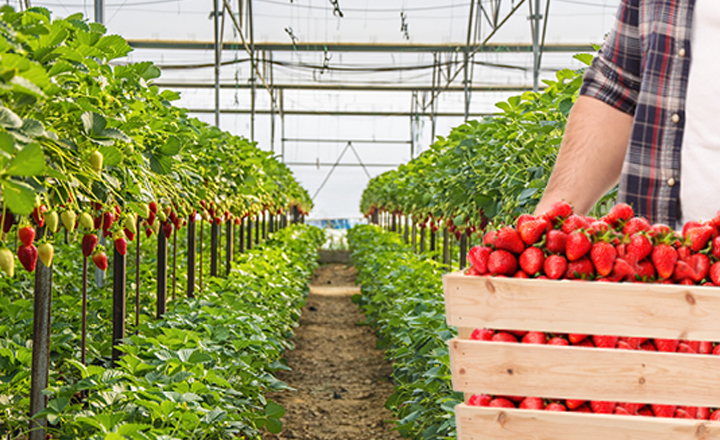Greenhouse farming is one of the most recommendable farming techniques in our modern times. It is a specialized farming approach where crops are grown inside unique shelters. These shelters are typically built from wooden frames (or steel frames) and transparent or translucent plastic. The major aim of greenhouse farming is to provide an environment for crops that are unaffected by natural weather or climatic conditions. That is the core reason why it is fast becoming the mainstream in Zimbabwe. You can check out a separate article I did on greenhouse farming in Zimbabwe. In it, I also gave an overview of the costs of setting up greenhouse farming. Today let us look at some of the most profitable greenhouse crops in Zimbabwe.
Tomatoes
This is one crop you can make lots of money with under greenhouse farming. One of the most talked about tomato varieties in Zimbabwe is the Trinity variety. Let us suppose you have 8 metres by 25 metres piece of land under a greenhouse. Following spacing recommendations, that would be 600 plants (if you choose to have 3 plants per square metre). From that, you can reap 18 kilograms of tomatoes per plant. That translates to 10.8 tonnes of tomatoes.
In monetary terms that would be around US$21 600 in gross revenue. Getting a greenhouse set up on 8 metres by 25 metres costs anything between US$3000 and US$5000 or so (depending on whether the greenhouse is wooden, metal, or hybrid). This is just an example to show how lucrative greenhouse tomato farming is.
Cucumbers
Cucumbers are a great fit for lucrative farming. They need just over 4 weeks to reach maturity. This means you can grow multiple batches in a year. This is enhanced also by the fact that cucumbers are heavily consumed in Zimbabwe. Over half of the population consume them regularly. Just think of the many braais held daily nationwide where cucumbers are a key ingredient. Anyways, on average, a healthy cucumber plant can produce roughly 20 cucumbers.
Let us assume you are setting up a greenhouse on a piece of land 8 metres by 25 metres. That piece of land can accommodate roughly 600 cucumber plants. This means you can reap about 12 000 cucumbers from a greenhouse sitting on that 8 metres by 25 metres of land. That will roughly get you around US$6000 in gross revenue.
Green Leafy Vegetables
Covo, cabbage, spinach, and rape, are some of the best choices. I need not say much about how profitable these can be. Many people growing these are doing so using open field approaches. When you employ the greenhouse approach, the yields can only be several times over. You will also enjoy the advantage of being to grow them all year round. You will also enjoy superior quality products as well. Greenhouse farming even enhances your shot at producing green leafy vegetables for export. There is always a market for these vegetables, making it possible to do several batches in a year.
Onions
Onions, just like green leafy vegetables, are a good choice for greenhouse farming. Almost every family or individual uses them to prepare relishes daily. Of course, they can be cultivated using open field methods but greenhouse farming has proven way better. Seed Co and Stark Ayres varieties are some of the commonly grown onion varieties in Zimbabwe. Some of the common Seed Co varieties are Elad F1, Neptune F1, Red Creole, Regent F1, Saturn F1, and Texas Grano. As for Stark Ayres, there is Irati, Ngwazi, Festive, and Goblin.
Peppers
There are so many different types of peppers to choose from. The ones you are most probably familiar with are what are called sweet peppers. Beyond those, there are banana peppers, piquillo peppers, cherry peppers, shishito peppers, hatch peppers, poblano peppers, and fresh peppers, just to mention a few. In total, there are over 20 different types of peppers. Peppers are a key ingredient in most cooked dishes. I love the flavour they bring into relishes. The market for peppers is inexhaustible which makes it worthwhile to grow peppers. Greenhouse farming guarantees that you produce top quality and high yields.
Microgreens
Microgreens are young vegetables usually between 2.5 and 7.5 centimetres in height. This is a relatively new focus in Zimbabwe but full of great potential. The handful of people already doing them is realizing good profits. Microgreens require little to no water to thrive. Plus they do not need that much space. The equivalent of garage space under a greenhouse can bring in thousands of US dollars monthly. You can successfully do them by setting up a small backyard greenhouse. Consider also that their average maturation period is 2 weeks.
What is there to not love about microgreens? Examples of microgreens are spinach, celery, broccoli, basil, lettuce, cabbage, peas, and coriander. They are simply tiny seedlings of edible plants. These are common inclusions in dishes; especially in upmarket restaurants – salads for example. This is one of the reasons why they fetch high market prices. For example, the selling price of 450 grams of mature microgreens can be around US$50.
Yields from greenhouse farming are often 100 times more than from open field farming. It is high time farmers in Zimbabwe seriously consider greenhouse farming. I have noticed that more and more players are entering the space. I am referring to companies offering greenhouse farming services. Notable examples I know of are AgriRocket Engineering and Total Farm Solutions. As more and more players come in that will gradually lower the prices. Regardless, with greenhouse farming recouping initial investments is mostly easy. This is due to high yields and good quality as well.









Hie
My name is Kudzaishe Chirobe. I found your post exciting and educative. Do you have any idea where I can get the Greenhouse paper material to use in constructing a green house.
Hello Kudzaishe, thanks for the question. You can find the materials at any hardware store but check out Farm and City to compare with others.